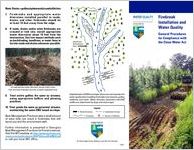Note Drains gullies/ephemerals/canals/ditches
7. F i r e b r e a k s a n d a p p r o p r i a t e w a t e r diversions installed parallel to roads drains and other firebreaks should be at least 10 feet away from the edge.
8. If roads drains and/or other firebreaks are crossed or tied into install appropriate water diversions about 10 feet from the intersection. Use low impact methods such as backblading handlines or water lines to tie into roads and drains whenever possible.
Forestland
Streamside Management Zone
Forestland
An appropriate water diversion moves water away from the main firebreak and into a stable vegetated area.
9. Treat active gullies the same as streams using appropriate buffers and plowing practices.
10. Treat ponds the same as perennial streams maintaining the same SMZ based on slope.
Best Management Practices take a small amount of extra time but result in firebreaks that will serve you and the environment well.
Further information is presented in Georgia s Best Management Practices for Forestry manual. Visit the GFC website at http //www.gatrees.org/ resources/publications/BMPManualGA0609.pdf or call your local GFC office.
Establishment of SMZs and water diversions are important for water quality when installing firebreaks near streams gullies wetlands and roads. Water diversion placement and SMZ widths are determined by slope and stream type.
Legend
Water Diversion Firebreak
Intermittent Stream Swamp or Wetland
An Equal Opportunity Employer and Service Provider 8/16
Firebreak Installation and Water Quality
General Procedures for Compliance with the Clean Water Act
The Georgia Forestry Commission is required to follow Best Management Practices (BMPs) when providing landowners with firebreak plowing services. BMPs are methods used to prevent or reduce soil erosion and water pollution as required by the federal Clean Water Act. Under the provisions of this Act landowners can be subjected to fines of amounts up to $50 000 per day for water quality violations that occur on their property. General procedures for pre-suppression firebreaks 1. Plan location of firebreaks.
Aerial photographs soil maps and topographic maps combined with an on-site evaluation will help identify the streams gullies and highly erodible sites on the property. Proper planning will ensure that firebreaks are effective and environmentally sound.
GFC Ranger and landowner plan firebreak location.
2. Use natural barriers such as roads and fields as firebreaks where possible.
A woods road serves as a natural firebreak.
3. Identify Streamside Management Zones (SMZs). SMZs are designated areas adjacent to streams or other bodies of water that require special management to protect water quality. They are determined based on steepness of the slope and whether the stream flow is intermittent or perennial. SMZ width may range from 20-100 feet (see Chart 1). Wider SMZs may be required for protected water supply reservoirs. a. Exclude firebreaks and intensive fire from SMZs when possible. b. If firebreaks must be connected to a stream construct them by using hand tools or by back-blading with a dozer in the SMZ.
Chart 1 - SMZ widths by slope class and stream type.
4. Install firebreaks on the contour rather than along property lines.
Ranger back blades with dozer to minimize soil disturbance in an SMZ.
5. Firebreaks installed with a flat blade or discharrow are preferred. These breaks erode less than plowed breaks.
6. Install appropriate water diversions in firebreaks according to BMP recommendations (see Chart 2).
A water diversion moves water away from the main firebreak and into a stable area. It is usually constructed with an angled berm of varying height that is suitable to redirect water flow across the full width of the firebreak. This angled berm is connected to an angled opening or turnout that will allow water to drain away from the break into a stable vegetated area.
Grade of Firebreak (percent)
Distance Between
Water Diversions (feet)
2
300
--------------------------5----------------------- ----- ------------------------------1--3-5---------------------
------------------------1--0------------------------ ------------------------------------8-0---------------------
------------------------1--5-- ---------- ----------- -------------------------------------6-0---------------------
------------------------2--0-- ---------- ----------- -------------------------------------4-5---------------------
------------------------3--0-- ---------- ----------- -------------------------------------3-5---------------------
------------------------4--0--*- ---------- ---------- -------------------------------------3-0---------------------
Chart 2 - Spacing of water diversions.
* Use grades of 40% and steeper only for short stretches.
